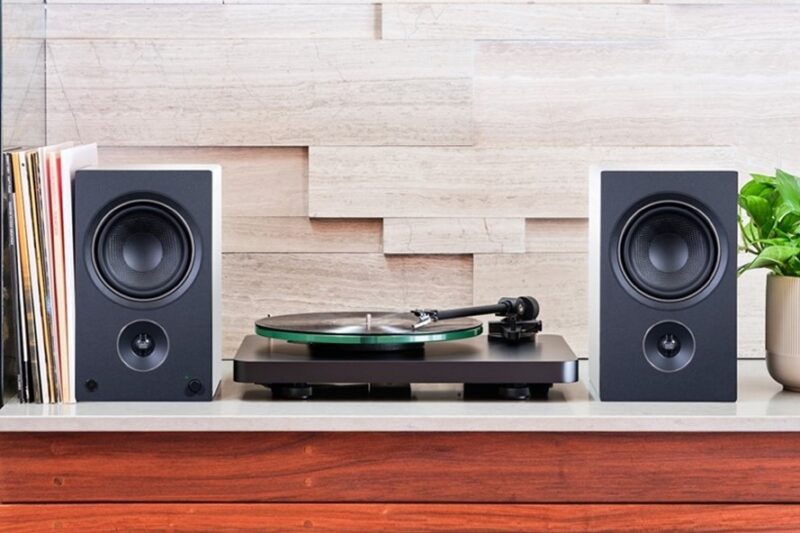PSB Speakers Makes System Building Stupid-Simple!
PSB Speakers’ revamped Alpha Series has been around for close to two years now, and ever since, we’ve considered it the pinnacle of budget loudspeakers. We named the Alpha P5 bookshelf ($329 at Amazon) the best speaker under $500 (they also garnered the Stereophile Product Of The Year Award), and the smaller Alpha P3 Bookshelf ($219 at Amazon) is just as good, only lacking a tiny bit of low-end response when compared to its larger sibling.
With that in mind, I wasn’t surprised to hear PSB was coming out with “powered” (meaning they have built-in amplification) versions of those exemplary speakers. I can’t think of a better base for an affordable integrated loudspeaker system.
A few weeks after their launch, I was lucky enough to get a hold of the Alpha AM5 Powered Bookshelf Speakers ($599), based on the Alpha P5 speaker mentioned above. I also had a chance to speak with Paul Barton, the founder of PSB Speakers, about his new creation, which was a treat!
A Chat With The Founder
During our brief phone conversation, Mr. Barton was gracious enough to share his inspiration for a powered Alpha Series and the rationale behind his design choices. He talked about being inspired by the growth in all-in-one speaker systems, and he also communicated his desire to develop a “simple plug and play” system for a younger hi-fi consumer.
He was also excited about the opportunity to optimize the sound of his new speakers with DSP. For example, in the AM5, he used DSP to adjust gain in proportion to the speaker’s port frequency, thereby extending the bass response beyond what was usually possible in a speaker that size.
Mr. Barton is clearly a man on a mission, someone looking to bring great sound to as many people as possible, especially those who don’t have a ton of money. As someone who came into this hobby when it wasn’t so friendly to those with short pockets (the late 90s), this was encouraging.

Build/Features
The Alpha AM5 is available in Matte White, or Matte Black finishes and comes with the same removable magnetic grilles as the Alpha P5. Unlike the P5, which has a woodgrain vinyl wrap, the AM5 has a plain vinyl wrap, making them look pretty nondescript. That could be seen as a benefit to some, but I would’ve liked to see the wood grain finish as an option.
The AM5’s overall dimensions of 6-3/4″W x 11-3/8″H x 9-1/2″ D match the passive version, but naturally, the powered set weighs more (21.5 lbs) since they have electronics built-in.
Like the Alpha P5 speaker, it’s a ported two-way design with a 5-1/4″ textured polypropylene woofer-3/4″ aluminum tweeter combo. Also, like the P5, the AM5 has an unconventional woofer-tweeter orientation. The woofer is set above the tweeter, aiming to provide the same sound to listeners whether they are standing or sitting.
Being powered speakers, the Alpha AM5 is supplied with a built-in 2-Channel, 50 watts per channel Class-D amplifier based on the same Hypex (HybridDigital) amp modules used by sister company NAD. The amplifier and the rest of the electronics are located in the left speaker, while the right side is passive. You get an eight-foot length of speaker wire to connect the two.
Unlike some other powered speakers (like the Kanto TUK), there’s no option to swap channels between the speakers. That limits placement options since the left speaker always has to be closer to the outlet than the right one. Between the AC adapter and cord, you get about 8 feet of distance from the speaker to the plug. Since the speakers use standard five-way binding posts, you can easily upgrade the speaker wire if you like.

On the backside of the active speaker, there are many connections for both analog and digital sources. They include a dedicated phono input for turntables (MM), a 3.5mm auxiliary input, an optical digital input, a mini Type B USB for connecting a computer, and a mono RCA output for connecting a subwoofer.
There’s also a wireless connection available in the form of Bluetooth with the aptX codec. AptX will give you close to CD-Quality sound if your device supports it.
A nice standout feature is the various Sound Modes that allow you to accentuate different parts of the music. Three modes accentuate dialog, soundstage, or both simultaneously, and I must say they work well. It’s like getting four speakers in one, a feat that can only be achieved in an integrated system like the AM5.
I had a chance to ask Paul Barton about the inspiration behind Sound Modes, and he said he wanted the speakers to appeal to as many people as possible sonically. He said they used Waves sound technology (plug-ins pulled from Pro Audio) to create the effects, and I told him I was impressed at how natural they sounded. It’s a pretty cool idea, and I’m surprised you don’t see it more in hi-fi powered bookshelf speakers.
The included remote control allows you to change volume, switch inputs, and sound modes, plus adjust the tone controls. There’s also a button to turn the subwoofer output on and off. It’s a nice remote, but I wish it had the option to control playback while using Bluetooth. Also, keep in mind you must have the remote perform certain functions like muting audio or cycling through Sound Modes.

Listening to the Alpha AM5 Bookshelf Speakers
For my sound tests, I set the Alpha AM5’s up in the same place and on the same stands I previously used for the Alpha P5 speakers. The stands were set up about 2 ½ feet from the rear wall, pointed directly at the listening position. I found that placement provided the best imaging and focus.
I did most of my sound tests with the three sound modes off, only using them after getting a good idea of what these speakers sounded like without them.
I started off streaming Bluetooth over aptX from my LG V60 phone, and I was amazed at how defined the sound was. I thoroughly enjoyed the imaging and placement of vocals within the soundstage, even though there could’ve been more depth to the presentation. Like the P5, the AM5 has a laid-back perspective, which allows you to sit back and let the music draw you in, as opposed to a more in your face speaker, which has a possibility of causing fatigue.
There wasn’t quite the amount of separation and air I would usually like to hear, but the detail was decent, and the timbre of instruments was very natural. Like the passive Alpha speakers, I found the midrange to be their strong point, with vocals and drums sounding really sweet. The passive models’ deep bass is also present, making these a good all-around speaker enjoy many different music genres.
I usually reserve BT for quick casual listening sessions, but I could see myself using the AM5’s Bluetooth for critical listening as well.

Next, I moved from the Bluetooth over to an Audiolab 6000N Play streamer connected via the optical digital connection. There was a slight improvement over the wireless connection, but not as much as I would’ve thought. To me, this wasn’t an indictment of the streamer’s quality but more a confirmation of the Bluetooth’s refinement.
That being said, when I played “Baker Street” by Livingston Taylor over the streamer, you could definitely hear a little bit more depth and transparency versus the wireless connection. However, there was still less air between the instruments and vocals than I would’ve liked. But, for the price point, these speakers hit a lot of audiophile buttons.
As I said earlier, three Sound Modes allow you to change these speakers’ sound signature with the touch of a button. Each mode made significant adjustments to the sound without harming the overall presentation, which was pretty cool.
The “dialogue” setting definitely added some clarity to vocals, and I could see this being pretty helpful when watching TV. The “soundstage” setting was probably the most impressive to me, expanding the soundstage well beyond the speakers’ boundaries without sounding like a big echo chamber. It added a little bit of space to the presentation, which sounded good to me.
The third setting, a combination of the two, both opened up the sound and pushed the mix’s vocals forward. I found the blend to be a bit too much, but YMMV. Some may find Sound Modes to be gimmicky, but I liked the option to change the sound signature for different types of music (and for TV watching). If you don’t like them, you can easily turn them off and enjoy the speaker’s inherent sound signature.

The Wrap-Up
For $599, the Alpha AM5 Powered Bookshelf Speaker gives you a complete audio system at a price that isn’t too far above the excellent passive Alpha speakers. They could use a touch more transparency, but they have good detail and imaging along with nice bass response. If you’re short on cash or space, and you want to dip your toes in hi-fi, these speakers should make you very happy. With this setup and a smartphone, you can have a hi-fi rig up and running in minutes.
PSB Speakers
$599
Amazon-SHOP NOW!
As an Amazon Associate, Hifitrends.com may earn from qualifying purchases via links placed throughout the site…this helps us keep the website going! Thanks in advance for your help! Prices are subject to change at any time.
Recommended Stories:

I’m an audio writer who started as a young audio salesman/consumer electronics professional back in the late 90s. That’s where I discovered the magic of 2-Channel sound. My thirst for great sound has led me on a delightful music quest that continues today.



Leave a Reply